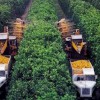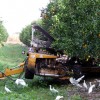 Mechanization has been the hallmark of American agriculture. Nearly 100 percent of the agronomic crops grown in the United States are plowed, planted, and harvested with mechanical equipment. Mechanical harvesting equipment for sweet oranges has been studied extensively since the 1970s and during the 2005/06 harvest season, trunk and canopy shakers harvested more than 36,000 acres of Florida citrus. Mechanically harvested citrus acreage, however, has decreased significantly since 2005. During the 2012/13 season, less than 9,000 acres were mechanically harvested (FDOC 2013). Nevertheless, development and adoption of mechanical harvesting technology is important to the long-term economic sustainability of the Florida orange juice processing industry. This 5-page fact sheet describing canopy shakerswas written by F.M. Roka, R.J. Ehsani, S.H. Futch, and B.R. Hyman, and published by the UF Department of Food and Resource Economics, August 2014.
Mechanization has been the hallmark of American agriculture. Nearly 100 percent of the agronomic crops grown in the United States are plowed, planted, and harvested with mechanical equipment. Mechanical harvesting equipment for sweet oranges has been studied extensively since the 1970s and during the 2005/06 harvest season, trunk and canopy shakers harvested more than 36,000 acres of Florida citrus. Mechanically harvested citrus acreage, however, has decreased significantly since 2005. During the 2012/13 season, less than 9,000 acres were mechanically harvested (FDOC 2013). Nevertheless, development and adoption of mechanical harvesting technology is important to the long-term economic sustainability of the Florida orange juice processing industry. This 5-page fact sheet describing canopy shakerswas written by F.M. Roka, R.J. Ehsani, S.H. Futch, and B.R. Hyman, and published by the UF Department of Food and Resource Economics, August 2014.
http://edis.ifas.ufl.edu/fe951
Tag: Reza Ehsani
Citrus Mechanical Harvesting Systems–Trunk Shakers
 While citrus growers are rightfully concerned about restoring the health of their HLB-infected trees, more study and consideration should be given to mechanical harvesting. The costs to grow and harvest citrus have been escalating significantly since 2006, and the cost savings potential from mechanical harvesting technologies can help Florida growers remain economically viable. This 4-page fact sheet was written by F.M. Roka, R.J. Ehsani, S.H. Futch, and B.R. Hyman, and published by the UF Department of Food and Resource Economics, August 2014.
While citrus growers are rightfully concerned about restoring the health of their HLB-infected trees, more study and consideration should be given to mechanical harvesting. The costs to grow and harvest citrus have been escalating significantly since 2006, and the cost savings potential from mechanical harvesting technologies can help Florida growers remain economically viable. This 4-page fact sheet was written by F.M. Roka, R.J. Ehsani, S.H. Futch, and B.R. Hyman, and published by the UF Department of Food and Resource Economics, August 2014.
http://edis.ifas.ufl.edu/fe950
Application of Auto-steering Technology for Tree Planting (AE475)
Setting up new orchards or planting new trees on existing beds is one of those orchard operations that have not yet been fully mechanized. Auto-steering technology can be used in conjunction with a tree planting unit to mechanize this operation and reduce tree planting costs. Learn more in this 5-page fact sheet was written by Reza Ehsani and Esa Ontermaa, and published by the UF Department of Agricultural and Biological Engineering,March 2011.
http://edis.ifas.ufl.edu/ae475
AE467 Grower Expectations of New Technologies for Applications in Precision Horticulture
AE467, a 4-page article by Reza Ehsani, Sindhuja Sankaran, and Cristian Dima, reports the results of a needs assessment focus meeting. It provides a synopsis of perceived apple and orange growers’ needs, expectations, and concerns related to the new technologies being developed for various precision horticulture applications. Published by the UF Department of Agricultural and Biological Engineering, October 2010.
http://edis.ifas.ufl.edu/ae467
AE466 Increasing Field Efficiency of Farm Machinery Using GPS
AE466, a 3-page illustrated fact sheet by Reza Ehsani, shows how Global Positioning Systems data can provide very useful information about the efficiency of agricultural equipment. Published by the UF Department of Agricultural and Biological Engineering, August 2010.
http://edis.ifas.ufl.edu/ae466
AE438 GPS Accuracy for Tree Scouting and Other Horticultural Uses
AE438, a 7-page illustrated fact sheet by Reza Ehsani, Sherrie Buchanon, and Masoud Salyani, provides citrus producers using GPS for citrus greening disease scouting with some simple explanations of the causes of GPS error and the level of accuracy that can be expected from different classes of GPS receivers. Published by the UF Department of Agricultural and Biological Engineering, January 2009.
http://edis.ifas.ufl.edu/AE438
AE444 Variable Rate Technology for Florida Citrus
AE444, a 5-page illustrated fact sheet by Reza Ehsani, Arnold Schumann, and Masoud Salyani, describes this important site-specific management component of precision agriculture which provides economic benefits to growers while reducing the application of agrochemicals. Includes references. Published by the UF Department of Agricultural and Biological Engineering, January 2009.
http://edis.ifas.ufl.edu/AE444